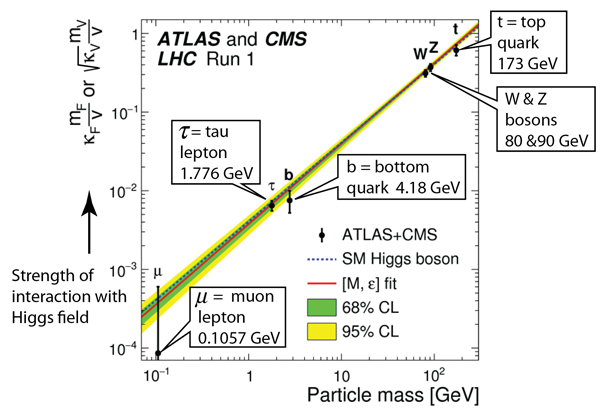The Higgs Boson
All the known forces in the universe are manifestations of four fundamental forces, the strong, electromagnetic, weak, and gravitational forces. But why four? Why not just one master force? Those who joined the quest for a single unified master force declared that the first step toward unification had been achieved with the discovery of the W and Z particles, the intermediate vector bosons, in 1983. This brought experimental verification of particles whose prediction had already contributed to the Nobel prize awarded to Weinberg, Salam, and Glashow in 1979. Combining the weak and electromagnetic forces into a unified "electroweak" force, these great advances in both theory and experiment provide encouragement for moving on to the next step, the "grand unification" necessary to include the strong interaction.
While electroweak unification was hailed as a great step forward, there remained a major conceptual problem. If the weak and electromagnetic forces are part of the same electroweak force, why is it that the exchange particle for the electromagnetic interaction, the photon, is massless while the W and Z have masses more than 80 times that of a proton! The electromagnetic and weak forces certainly do not look the same in the present low temperature universe, so there must have been some kind of spontaneous symmetry breaking as the hot universe cooled enough that particle energies dropped below 100 GeV. The theories attribute the symmetry-breaking to a field called the Higgs field, and it requires a new boson, the Higgs boson, to mediate it.
 Illustration courtesy Fermilab, D0 Experiment. |
Early formulation of the theories estimated that the Higgs boson would have mass energy in excess of 1 TeV, making the energies for discovery almost unattainable on the earth. Now, since the discovery of the top quark, there was tantalizing evidence that the Higgs boson might have energies in the range of a few hundred GeV and therefore within the range of present day accelerators. At Fermilab, data from the D0 detector facility is used with the masses of the W and the T quark to estimate the mass of the Higgs boson. Suggestions that it may have a mass below 200 GeV made it one of the high priorities for high energy physics. |
Searching for the Higgs boson was one of the high priority objectives of the Large Hadron Collider at CERN. At the end of 2011, the LHC results appeared to limit the Higgs to between 114 and 145 GeV if it is to fit in the standard model of particle physics. Then in 2012 a peak at 125 GeV was found by both the Atlas and CMS detectors, and by 2013 there was confidence that a Higgs boson had been found.
| The Path to the Higgs |
| The Atlas and CMS Experimental Detection |
| The Higgs Field |
Fundamental force concepts
Higgs Vimeo
Higgs Vimeo
Atlas bulletin on Higgs
Higgs boson Wiki
| HyperPhysics***** Quantum Physics | R Nave |


